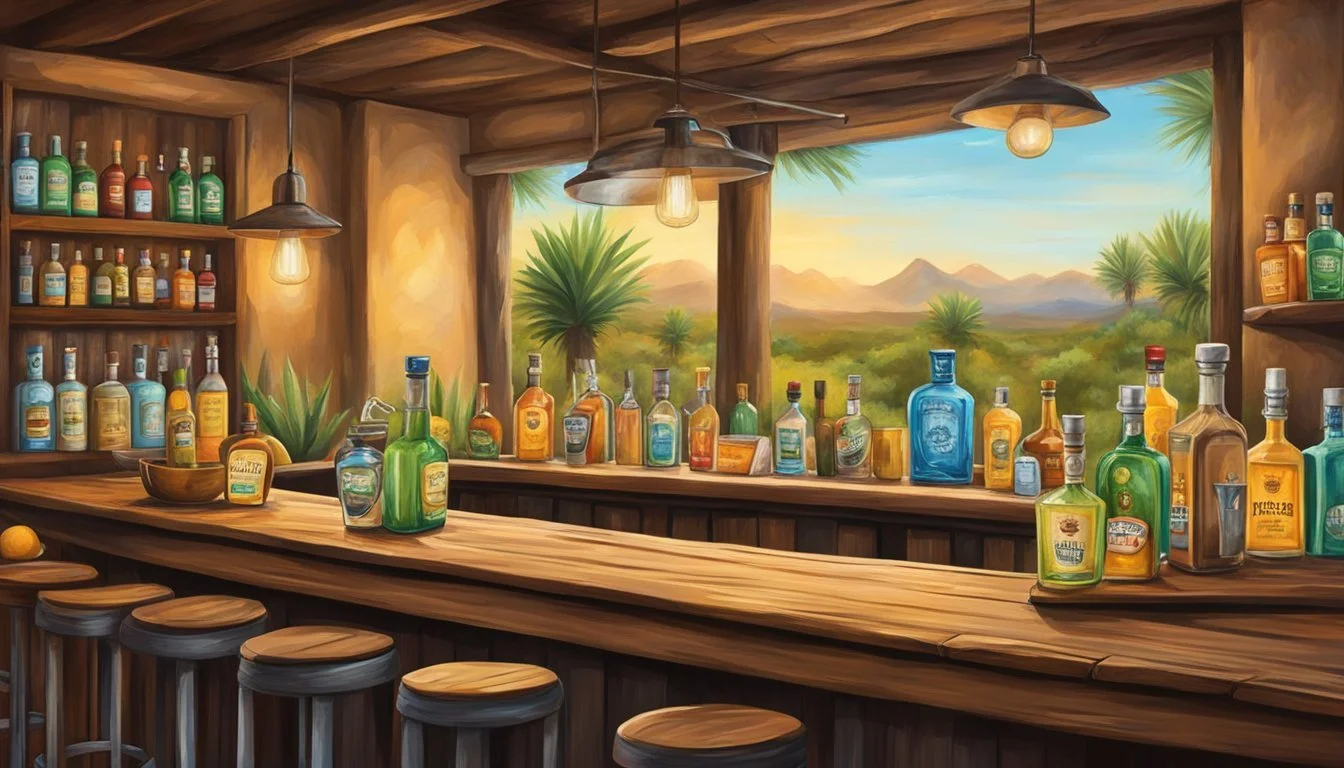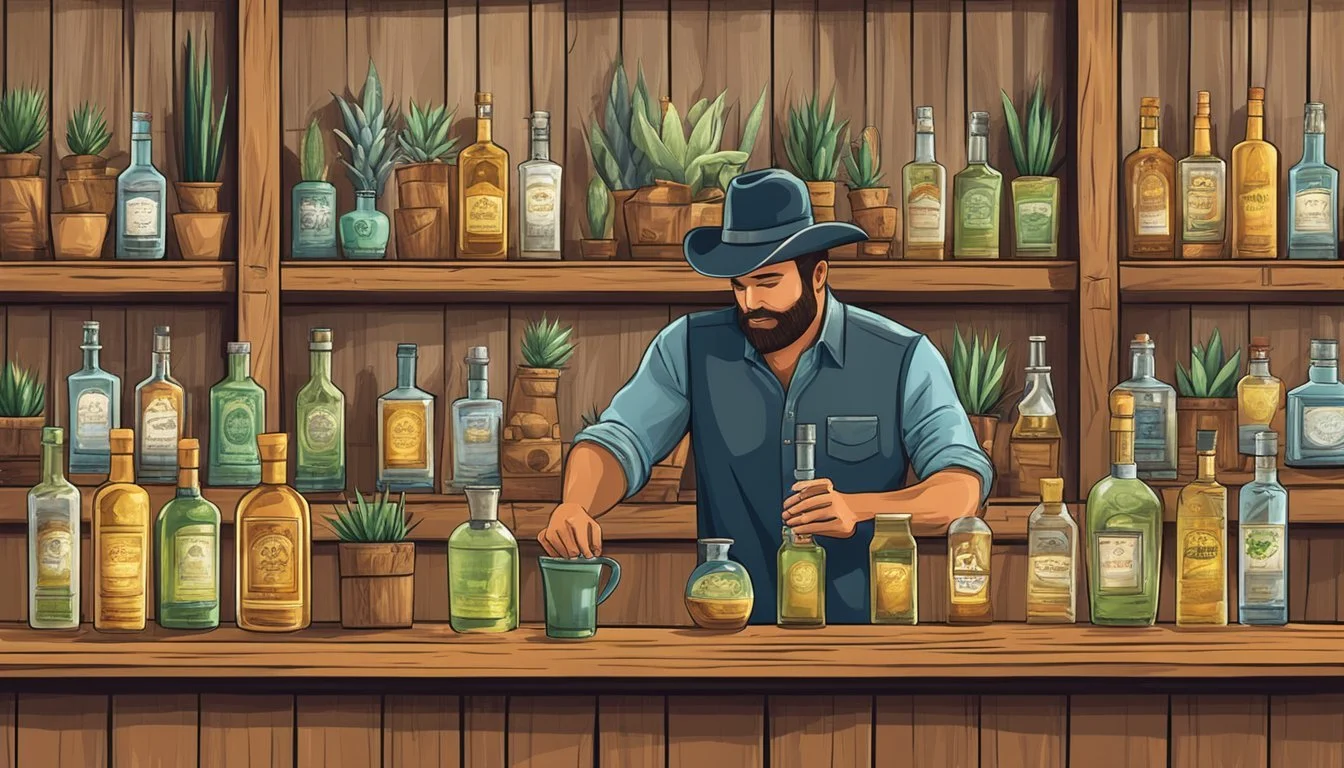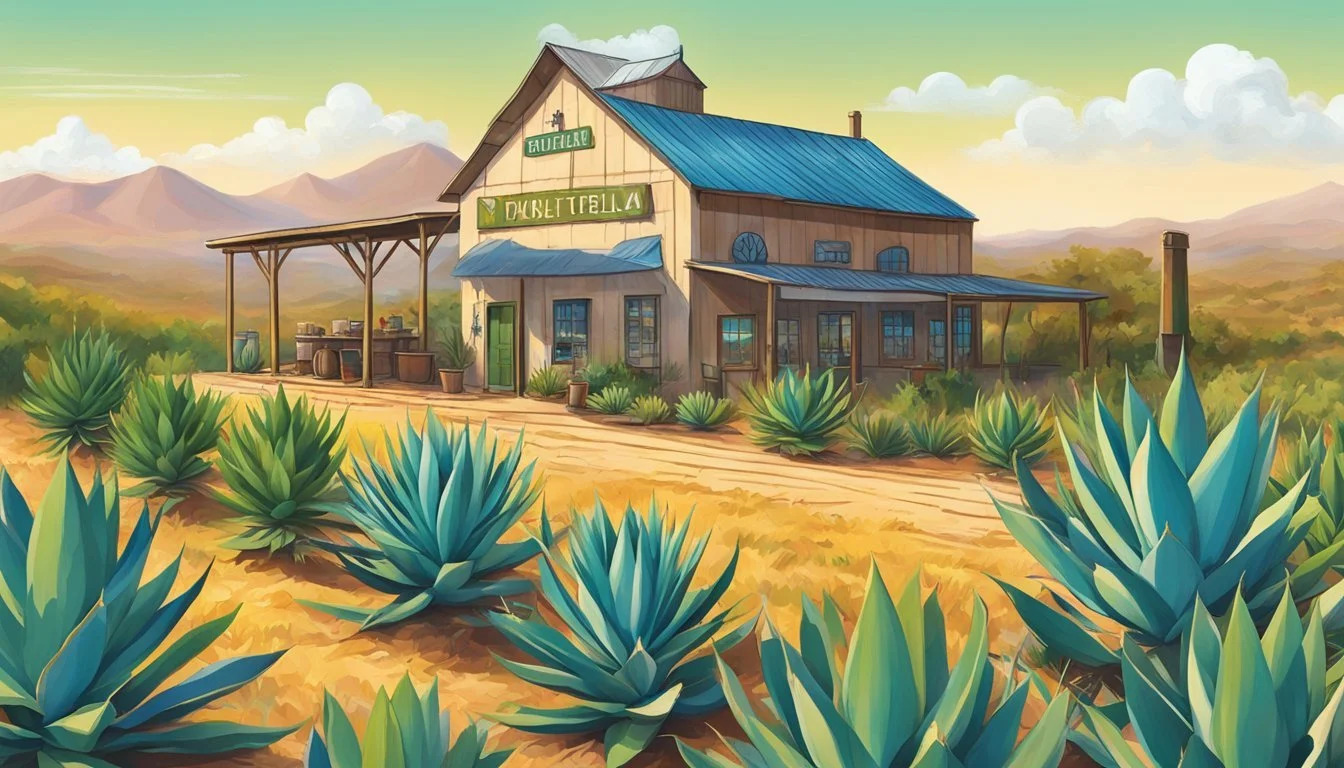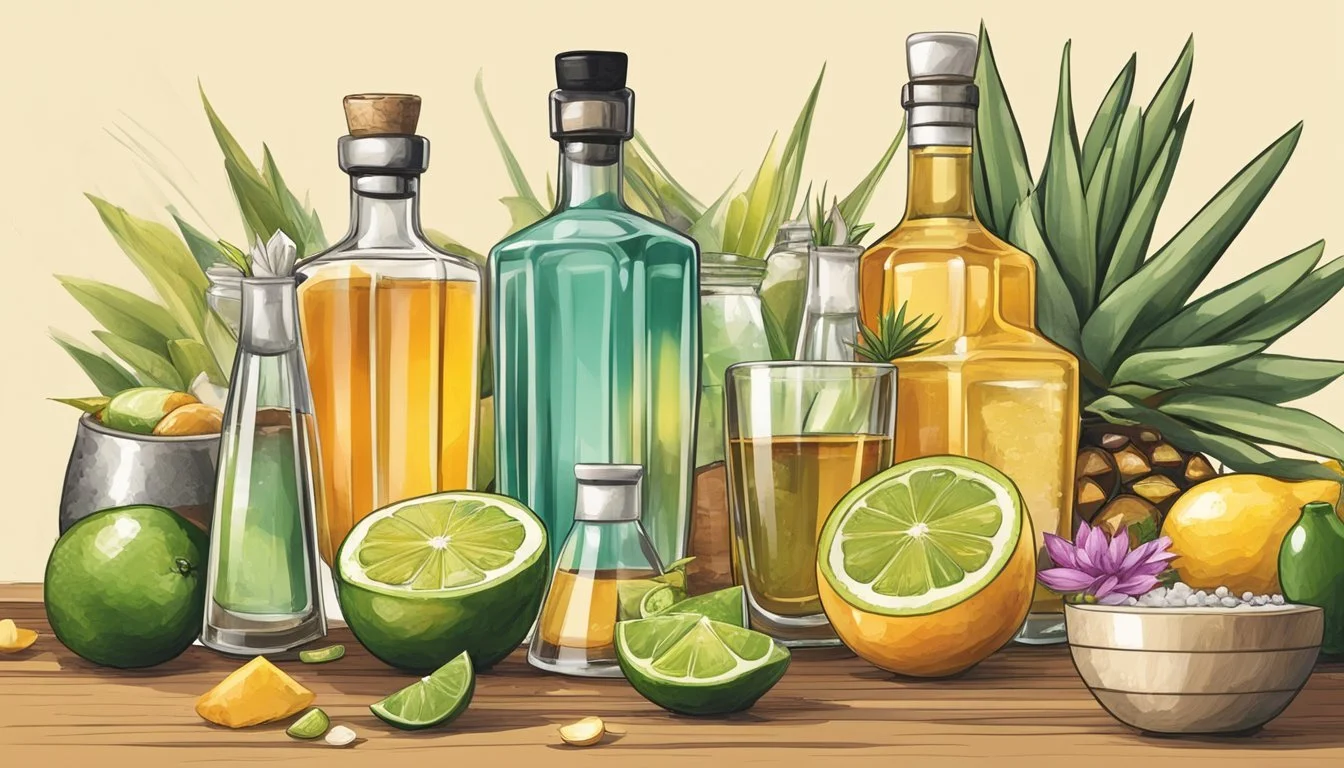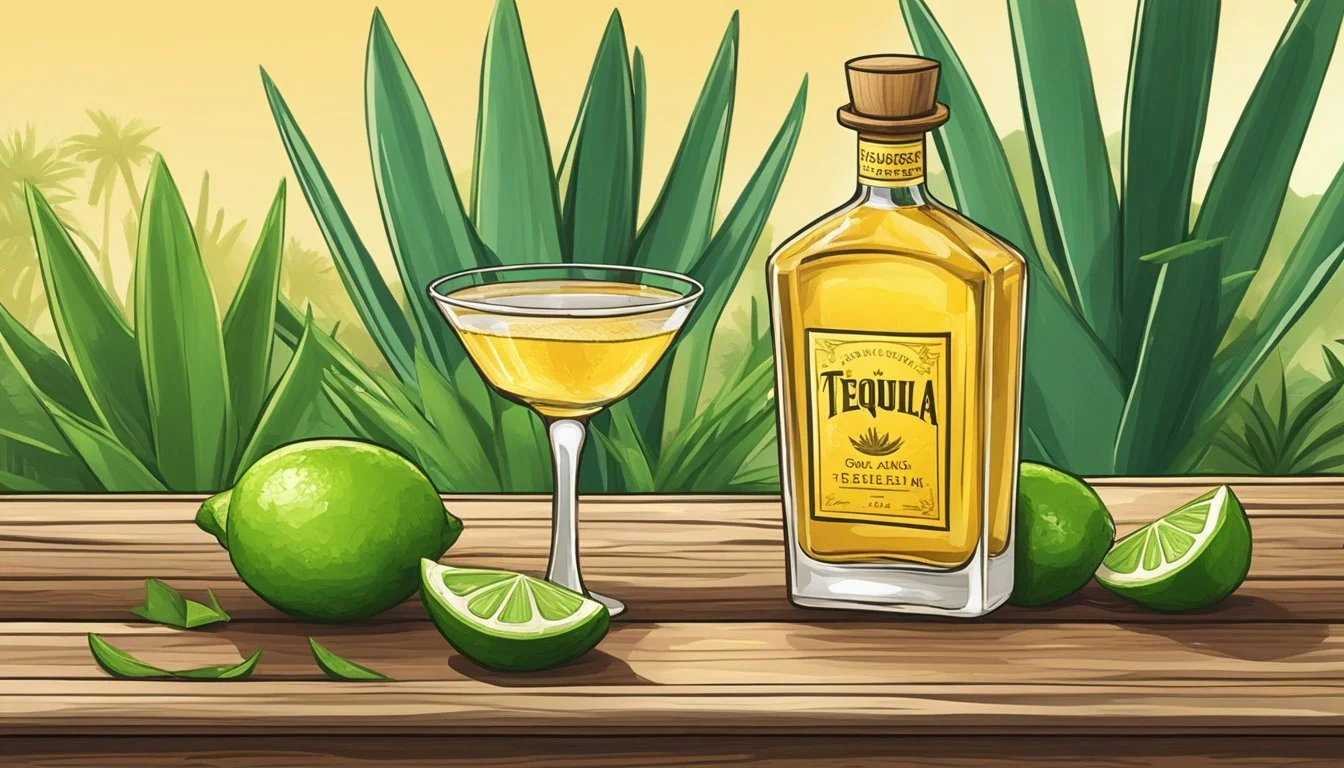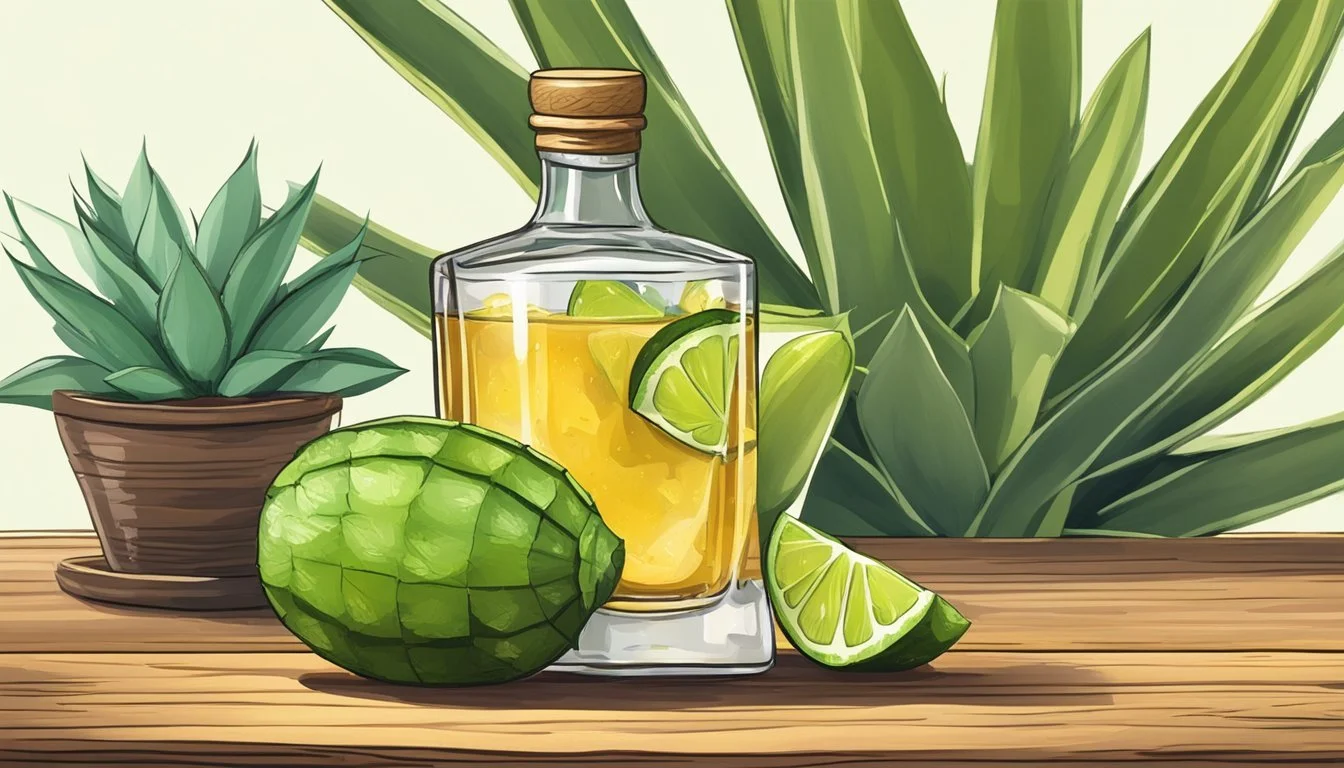Tequila and Agave Nectar
Elevating Texas Cocktails with Natural Sweetness
Tequila, distilled from the blue agave plant native to Mexico, has made its way into the heart of Texas cocktail culture, offering a robust and versatile base for a plethora of mixed drinks. This spirit's natural companion, agave nectar, is a sweetener derived from the same plant, boasting a sweeter profile than sugar and a consistency thicker than honey. This golden syrup is becoming increasingly popular in the Lone Star State's bars for its ability to impart a smooth, natural sweetness to cocktails without overpowering the other flavors.
In Texas, where innovation meets tradition, bartenders are harnessing the flavor profiles of tequila and agave nectar to craft beverages that range from classic to contemporary. They are known for concocting drinks with a regional twist, whether it be a spicy kick from local jalapeños stirred into a Spicy Ranch Water or a Beergarita that marries the effervescence of beer with the tartness of lime, demonstrating how Texas mixologists value the authentic taste that tequila and agave nectar offer.
With a nod to sustainability and a push for natural ingredients, the use of agave nectar in lieu of artificial sweeteners or processed sugars in Texas cocktails speaks to a broader trend. Consumers are increasingly looking for drinks that not only taste good but also contain ingredients that align with a more health-conscious, environmentally-aware lifestyle. The natural sweetening power of agave nectar combined with the distinctive flavor profile of tequila gives rise to a unique genre of Texas cocktails that cater to modern tastes while staying true to cultural roots.
Exploring Tequila
Tequila is a distinctive spirit deeply rooted in Mexican heritage, crafted from the blue agave plant and renowned for its various expressions. Whether sipped neat or mixed in cocktails, each type of tequila presents a unique flavor profile worth exploring.
The Origin of Tequila
Tequila's history begins with the indigenous peoples of Mexico, who initially fermented agave to create a traditional drink. The blue agave plant (Agave tequilana), native to Jalisco, Mexico, is the only source for producing authentic tequila. The denomination of origin requires that tequila can only be produced in specific regions of Mexico, ensuring the drink's authenticity and heritage are preserved.
Types of Tequila
There are primarily two categories of tequila:
100% Blue Agave: Made exclusively from blue agave juice.
Mixto Tequila: Contains a minimum of 51% blue agave, with the remainder typically being cane sugar.
Moreover, tequila is aged to varying degrees to produce different types:
Silver Tequila (Blanco): Clear, unaged tequila that exhibits the purest taste of agave.
Gold Tequila (Joven): A mixto tequila often colored and flavored to mimic aged tequilas.
Reposado Tequila: Aged between 2 months and 1 year in oak barrels, offering a balance between the agave and wood flavors.
Añejo Tequila: Aged between 1 and 3 years, resulting in a smoother, richer flavor profile.
Tequila Tasting Notes
Tasting tequila involves observing its color, aroma, and flavor:
Silver Tequila: Features a bright, clear appearance, with fresh and crisp agave flavors accompanied by citrus and green, grassy notes.
Reposado Tequila: Presents a golden hue, offering a harmonious blend of agave and oaky notes with hints of caramel and vanilla.
Añejo Tequila: Exhibits a deeper amber color, and it's known for a complex flavor palette including caramel, vanilla, chocolate, and a smooth finish due to extended aging.
The Significance of Agave Nectar
Agave nectar, a sweet syrup from the blue agave plant, has gained traction in Texas cocktails for its natural sweetness. Its distinct taste and processing methods highlight its role as a favored natural sweetener.
Agave Nectar Vs. Other Sweeteners
Agave nectar distinguishes itself from other sweeteners like honey and cane sugar due to its lower glycemic index, meaning it does not spike blood sugar levels as rapidly. It also has a sweeter taste; therefore, less quantity is needed to achieve similar sweetness levels. While honey is often praised for its natural benefits, agave nectar is vegan-friendly, offering a plant-based alternative for sweetening beverages and foods.
Production Process of Agave Nectar
The production of agave nectar involves extracting sap from the piñas, or cores, of the agave plant and then filtering and heating it to break down its components into a simple syrup. This process differs significantly from that of tequila, where the sap is fermented and distilled. Only the species such as agave tequiliana is used for agave syrup production.
Health Benefits and Concerns
Health-wise, agave nectar contains fructans, which are thought to have beneficial effects on metabolism and insulin. However, it's high in fructose, comparable to that found in high-fructose corn syrup, which can be a concern for health-conscious consumers. Therefore, moderation is key when incorporating agave nectar into a diet as with any sweetener.
Classic and Contemporary Cocktails
In the realm of tequila and agave nectar, classic cocktails like the Margarita stand the test of time while contemporary recipes offer innovative twists to refresh the palate.
The Art of Margaritas
Margaritas have cemented their status as a quintessential tequila cocktail. While traditional Margaritas combine tequila, lime juice, and orange liqueur or triple sec, many recipes now advocate for the substitution of artificial sweeteners with agave nectar to enhance the natural tequila flavors. A notable variation is Tommy's Margarita, which omits orange liqueur in favor of agave nectar and freshly squeezed lime juice, spotlighting the agave plant’s full spectrum of flavors.
Paloma: A Refreshing Alternative
The Paloma, often overshadowed by its more famous cousin, offers an invigorating taste featuring a blend of tequila and grapefruit soda or juice, accented with a hint of lime. This cocktail serves as a perfect refreshing drink on a warm summer day. The Paloma stands out for its smooth juxtaposition of sweet and tart flavor profiles, making it a beloved choice for those seeking something less conventional than a Margarita but equally representative of traditional Mexican cocktails.
Innovative Recipes with Agave and Tequila
Fusion and creativity define the array of contemporary cocktail recipes integrating tequila and agave nectar. From twists on classics, such as the Spicy Tequila Old Fashioned featuring agave syrup and a punch of jalapeño, to novel concoctions like the Tequila Sunrise — a visually impressive mix of tequila, orange juice, and grenadine — the versatility of agave nectar in cocktails continues to expand. Each recipe embraces the spirit of innovation while respecting the authenticity of tequila's heritage.
Combining Tequila with Other Spirits
Tequila, a spirit distilled from the agave plant, forms the foundation of many classic and modern cocktails. When paired with other spirits, its versatility shines, offering a broad canvas for mixologists to create beverages that range from smoothly balanced to boldly innovative.
Tequila and New Age Mixology
Modern mixology embraces tequila's adaptability, often combining it with a variety of spirits to explore new flavor frontiers. Mezcal, with its smoky notes, is a natural companion to tequila in cocktails, enhancing the earthiness of the agave. Bartenders may also experiment with vodka for a clean, crisp profile or gin for a botanical twist. The primary goal is to complement tequila's bright and bold character without overpowering it.
Common Tequila-Infused Cocktails:
Tequila and Mezcal: Enhanced smoky flavors
Tequila and Vodka: Reinforced crispness
Tequila and Gin: Additional botanical layers
Popular Tequila Pairings
In the landscape of spirit pairings, tequila plays well with a range of companions. Spirits like bourbon and whiskey bring a rich complexity and warmth to tequila cocktails. Agave cocktails often include a hint of jalapeño or citrus to accentuate the innate flavors of tequila. These spirits are carefully balanced to ensure each ingredient shines through.
Favorite Pairings Include:
Bourbon: Adds a vanilla and toffee dimension
Whiskey: Introduces subtle oak and spice
Jalapeño: Offers a spicy kick
Citrus: Provides a refreshing zest
The Science of Flavor Combinations
The art of combining tequila with other spirits is rooted in science, where the aim is to achieve a complementary and balanced flavor profile. Spirits such as sotol, with its herbaceous and earthy notes, can be mixed with tequila to create a complex, layered effect. Bitter elements often play a role in rounding out the sweetness of agave nectar, creating a sophisticated and complete taste experience.
Strategic Flavor Pairings:
Smoky: Mezcal enhances the deep earthy notes in tequila.
Earthy: Sotol brings forward the herbal characteristics.
Bitters: They offset the sweetness for a balanced cocktail.
By understanding the nuances of each spirit and how they interact, one can construct cocktails that are not only delicious but also showcase the subtleties of tequila's dynamic range.
Enhancers and Modifiers
When crafting cocktails, modifiers such as syrups and nectars are essential for flavor balance. They not only add sweetness, but also contribute to the overall depth and complexity of the drink. The use of citrus and spices complements the nectar's sweetness, offering an array of combinations to explore.
Agave Nectar as a Modifier in Cocktails
Agave nectar, with its honeylike consistency, provides a natural sweetness to cocktails without overpowering other ingredients. Its flavor profile—a subtle, nuanced sweetness—is a match for Tequila-based drinks where it complements rather than competes. While traditional simple syrups contribute just sweetness, agave nectar also imparts a slight floral note, enriching the cocktail’s flavor.
The Role of Citrus and Salt
Citrus components like lime juice, lemon juice, and orange juice serve more than one purpose; they add essential acidity and highlight the tequila’s crispness while tempering the agave nectar’s sweetness. The addition of salt, either rimmed or in small quantities within the drink, acts as a flavor enhancer, bringing out the nuances of both the spirits and the sweeteners used.
Lime juice is often used in margaritas for its bright, zesty character.
Salt can either accentuate flavors or soften the sweetness, depending on its application.
Experimenting with Spices and Herbs
Inventive mixologists may incorporate spices and herbs like cilantro, basil, or jalapeño, to introduce a new dimension to Tequila cocktails with agave nectar. Spicy cocktails gain heat and a vibrant color with muddled jalapeños, while cilantro can give a fresh, earthy undertone to the concoction. Experimenting with such elements can evolve the profile of classic drinks into something excitingly contemporary.
Jalapeño: A slice or two adds heat, which contrasts well with sweetness and citrus.
Basil: Muddled leaves contribute a fragrant, peppery note.
Cocktail Presentation and Aesthetics
The art of cocktail presentation is crucial in enhancing the drinking experience. Thoughtful garnishing, the choice of glassware, and the visual appeal of the drink's color work in harmony to delight both the palate and the eyes.
Garnishing with a Purpose
Garnishing serves both an aesthetic and functional purpose in cocktail crafting. An orange peel not only adds a splash of vibrant color but also imparts subtle citrus aromas when expressed over the drink. Strawberries or blackberries can be used to introduce a fresh contrast, both visually and in flavor. Each garnish should complement the cocktail's profile, adding to the overall sensory experience.
Glassware and the Drinking Experience
The choice of glassware is more than a mere vessel; it's an integral part of the presentation and the drinking experience. For instance, a highball glass might be chosen for a cocktail featuring sparkling mineral water to accentuate the carbonation and length of the drink. The shape of the glass can enhance aromas and facilitate the texture of the cocktail on the palate.
Cocktail Type Suggested Glassware
Agave nectar mixed drinks Rocks or old-fashioned glass
Sparkling cocktails Flute or highball glass
Color and Appearance in Cocktail Crafting
The visual allure of a cocktail is paramount, with color playing a starring role. The natural hues of tequila and agave nectar lend a warm amber or golden appearance, while mixers and modifiers can add layers of color. The choice of ingredients should create an inviting palette, ensuring that the cocktail is as beautiful as it is delicious. Clear or lightly colored options spotlight the purity and quality of the spirits used.
Non-Alcoholic Variations
Non-alcoholic drinks have gained popularity for those wishing to enjoy the essence of traditional cocktails sans the alcohol content. By utilizing agave nectar, individuals can relish sweeter nuances in their beverages without compromising on taste.
Agave Sweetened Mocktails
Agave nectar serves as an excellent sweetener in mocktails, owing to its natural origins and rich flavor that mimics the complexity of tequila. A Virgin Margarita can easily be concocted by combining this nectar with freshly squeezed lime and orange juice. The blend can be enhanced by stirring it with ice in a pitcher and serving it chilled. Similarly, the Paloma Mocktail marries non-alcoholic tequila with grapefruit juice and lime, sweetened with light agave syrup to deliver a palatable delight.
Virgin Margarita Components:
Agave nectar
Lime juice
Orange juice
Ice
Sparkling water for topping
Paloma Mocktail Steps:
Mix non-alcoholic tequila, grapefruit juice, lime juice, and agave.
Bringing Refreshment without the Buzz
For those seeking the effervescence of a cocktail without alcohol, elements such as club soda or sparkling water add the requisite fizz without the buzz. Mixers like ginger beer can impart a spicy kick to the concoction, while bitters can introduce aromatic complexity to the mocktail, creating a sophisticated flavor profile that caters to the palate accustomed to nuanced cocktails.
Effervescent Add-ins:
Sparkling water
Ginger beer (for a kick)
Bitters (for complexity)
Using these ingredients, bartenders craft beverages that rival their alcoholic counterparts regarding taste and presentation. Whether for health reasons, personal preference, or simply to take a break from alcohol, these non-alcoholic alternatives offer a refreshing and inclusive option for all patrons.
Cultural Impact and Trends
Agave-based spirits like tequila have strongly influenced both popular culture and the cocktail scene, with a clear trend towards sustainability in production practices.
Tequila in Popular Culture
Tequila has long surpassed its status as just a spirit, taking on a persona in movies, music, and social events that symbolizes fun and celebration. Celebrities and influencers often endorse premium brands, further ingraining tequila in the fabric of nightlife and entertainment. Julio Bermejo is known for popularizing the Tommy's Margarita, a twist on the classic, which exclusively uses tequila blanco, highlighting the pure taste of the agave plant.
Trends in Tequila Cocktails
Bartenders across Texas and beyond are constantly innovating, crafting cocktails that showcase the versatility of tequila. A staple in this mixology revolution is the Ranch Water, a refreshing combination of tequila, lime juice, and sparkling mineral water. The inclusion of Grand Marnier in cocktails continues to flourish, introducing a subtle, sophisticated sweetness that complements the agave's natural flavors.
Popular Tequila Cocktails:
Margarita: Tequila, lime juice, orange liqueur
Paloma: Tequila, grapefruit soda, lime
Ranch Water: Tequila, lime juice, sparkling mineral water
Sustainable Practices in Tequila Production
Sustainability has become a pivotal concern in tequila production. Distilleries in Mexico are increasingly adopting eco-friendly practices to ensure the long-term sustainability of the agave plant. Efforts include the efficient use of water, recycling byproducts, and exploring renewable energy sources. These practices ensure that the industry preserves the environment and the cultural heritage that tequila embodies.
Advanced Mixing Techniques
In crafting high-quality cocktails, the precise techniques in mixing are crucial for achieving the ideal texture and flavor. Utilizing cutting-edge tools allows bartenders to enhance the natural sweet profiles of tequila and agave nectar.
The Role of Mixing in Texture and Flavor
When bartenders mix a cocktail, they are not only combining ingredients but also manipulating the texture and unlocking flavors. For instance, shaking a Mojito integrates the bright citrus and mint flavors while adding a slight frothiness to the texture. Similarly, employing a dry shake—shaking without ice—allows an egg white to emulsify in a Cantarito, creating a silky foam that elevates the drinking experience.
To exemplify precision in flavor balance, consider the Añejo Old Fashioned. A bartender might use mixing techniques to ensure that the smokiness of añejo tequila is not overwhelmed by the sweetness of agave nectar or overpowered by the zest of orange bitters.
Sidecar: The shake intensity can influence the fusion of tart and sweet profiles.
Moscow Mule: Gentle stirring preserves carbonation and prevents the dilution of ginger beer.
Innovative Tools for Today's Bartender
Advancements in bartending equipment have made it easier for mixologists to consistently deliver high-quality drinks.
The Spiral Mixer: Enhances the blending of agave nectar in complex drinks such as an Aperol-based cocktail, ensuring a smooth texture.
Contemporary mixologists might also employ tools such as the digital scale for precise measurements or a refractometer which assesses sugar levels, allowing for a sophisticated balance between the natural sweetness of agave nectar and the savory notes of premium tequila.
In using state-of-the-art mixing tools and a deep understanding of cocktail texture and flavor profiles, bartenders can craft exquisite, naturally sweetened Texas cocktails.

